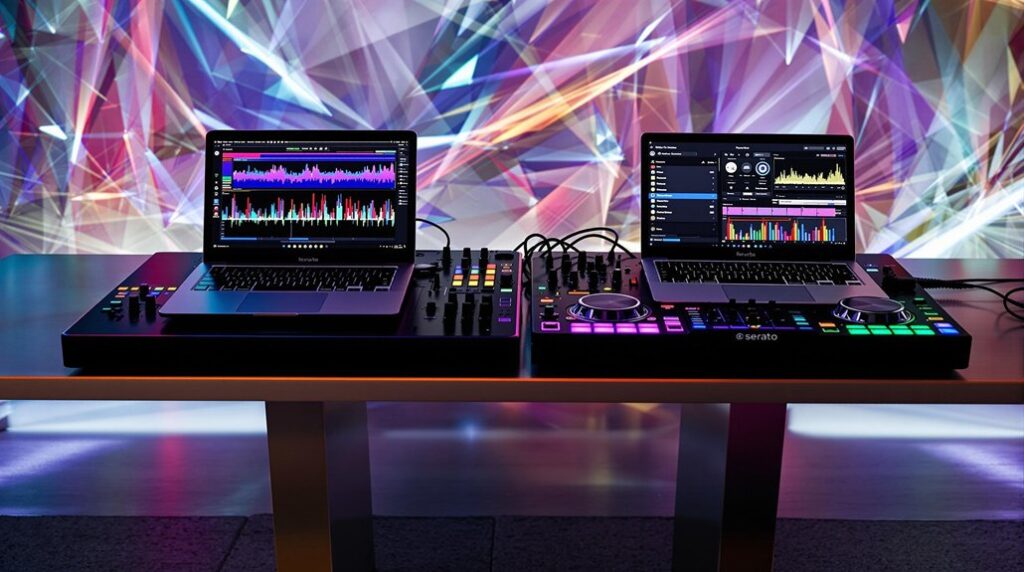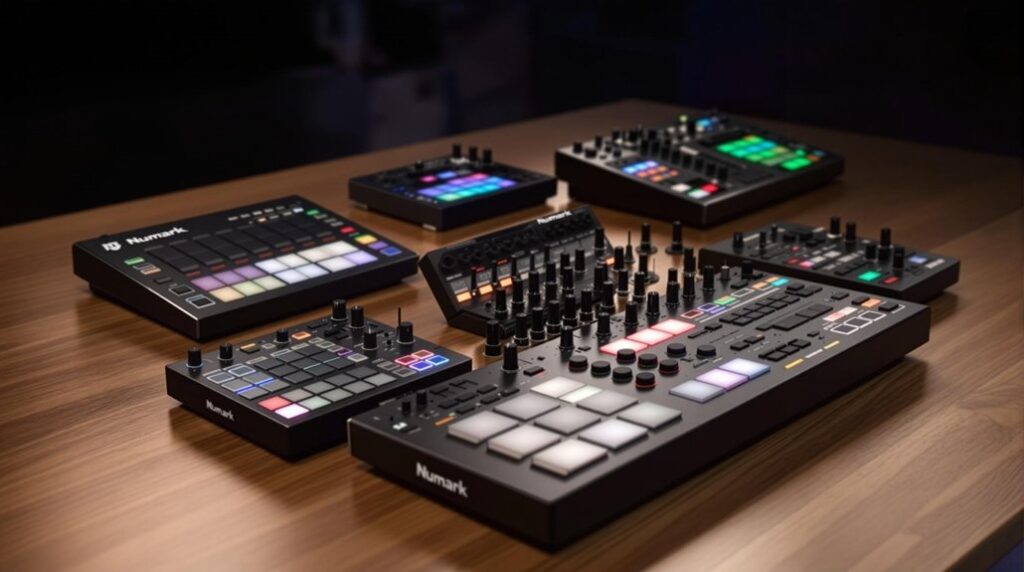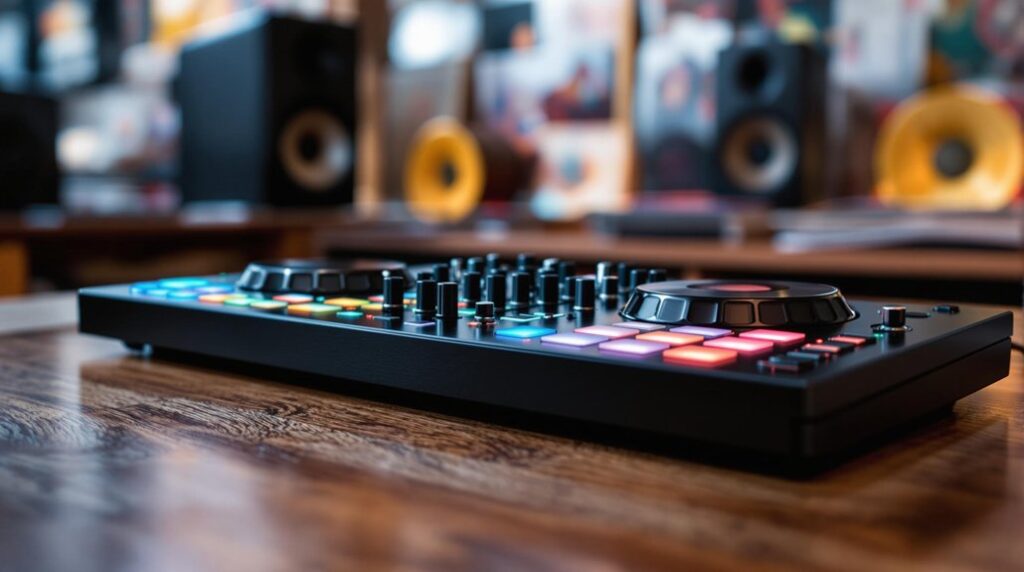Mastering BPM tapping like a pro involves creating a superior environment with the DAW’s transport window and MIDI controls. Selecting precise tools, such as responsive MIDI controllers, enhances accuracy. Practicing even, consistent taps with diverse audio tracks sharpens timing skills. Utilizing MIDI devices streamlines real-time tempo adjustments. Overcoming challenges requires practice with metronomes and verifying DAW settings. Continuous refinement and applying BPM tapping techniques can raise music projects to professional standards.
Key Takeaways
- Practice with a metronome to maintain consistent rhythm and improve timing accuracy.
- Use MIDI controllers for tactile feedback and seamless integration with DAWs like Pro Tools.
- Enable “Use MIDI to Tap Tempo” in DAW settings for precise tempo control.
- Regularly record and review tempo data to identify and correct inconsistencies.
- Experiment with different tapping surfaces for comfort and enhanced precision.
Setting Up Your Environment for BPM Tapping
Establishing an ideal setup is critical for precision. Users must guarantee their digital audio workstation (DAW), such as Pro Tools, has the transport window open with MIDI Controls and Expanded Transport enabled. This configuration enhances tempo management during tapping. MIDI devices, like keyboards or drum machines, should be connected and configured for seamless MIDI input, facilitating accurate tap tempo execution. Practicing with the tap tempo feature is crucial, as consistent rhythm tapping improves timing accuracy. Employing a responsive tapping surface, like a MIDI pad, allows for swift taps. Additionally, adjusting the reference track’s volume guarantees the beat is audible without interference, refining the entire BPM tapping process. Ensuring software compatibility and performance can help avoid latency issues and ensure optimal operation of your DAW and MIDI devices.
Choosing the Right Tools for Accurate BPM
Selecting the right tools for precise BPM tapping involves integrating reliable software solutions, such as those found in industry-standard DAWs like Pro Tools, which offer robust BPM calculators and tap tempo functionalities.
Utilizing MIDI controllers enhances this setup by providing a tactile interface that guarantees precision, particularly when syncing with live instruments.
Confirming ideal device compatibility is essential, allowing musicians to seamlessly incorporate these tools into their existing workflow, thereby enhancing both accuracy and efficiency in their rhythmic endeavors.
For DJs, choosing software with real-time track analysis is crucial for maintaining precise beat matching, ensuring high-quality transitions and seamless performance.
Essential BPM Tools
Steering through the vast terrain of BPM tools requires a discerning eye for functionality and integration.
Essential tools for achieving accurate tempo include MIDI devices, which can be leveraged as tapping devices to interface seamlessly with DAWs like Pro Tools. This integration allows users to set the tap tempo in Pro Tools directly from the hardware, guaranteeing precision.
Many DAWs, including Pro Tools, offer built-in tap tempo features that average multiple taps, providing a refined BPM measurement. For those seeking enhanced accuracy, the following tools are indispensable:
- Reliable BPM calculator: Streamlines tempo determination.
- Metronome app: Offers real-time tapping and visual tempo displays.
- Click track: Aids musicians in developing consistent timing.
- Tempo syncing software: Guarantees cohesive project alignment.
- MIDI controllers: Facilitates seamless DAW integration.
Selecting Reliable Software
Steering through the realm of BPM software involves discerning choices that blend functionality with precision.
Prioritizing digital audio workstations, such as Pro Tools, is advisable due to their built-in tap tempo functions, allowing for real-time adjustments to find the tempo seamlessly. Integrating a MIDI device enhances this experience, providing intuitive control and precision.
When selecting software, one should seek applications that calculate average tempo over multiple taps, ensuring accuracy. Tempo mapping and synchronization features are pivotal for streamlining workflows and maintaining consistency across productions.
A user-friendly interface with visual feedback is essential for effective tempo adjustments. Such features collectively enable music producers to tap BPM like seasoned professionals, ensuring both accuracy and creativity in their projects.
Optimal Device Compatibility
To achieve ideal device compatibility when tapping BPM, one must meticulously select tools that harmonize with their digital audio workstation. Choosing the right MIDI controller is paramount, as devices with responsive pads or keys facilitate precise rhythm input, leading to the correct tempo.
Confirming compatibility between the MIDI device and DAW, such as Pro Tools, requires checking for built-in support or necessary drivers.
Key considerations include:
- Responsive MIDI controllers with tactile feedback
- Low latency devices for immediate input recording
- Metronome apps on smartphones/tablets for versatile tempo to match
- Audio interfaces that support MIDI I/O for real-time synchronization
- DAWs with seamless integration capabilities
These elements confirm accurate BPM settings, maintaining the integrity of musical creations across platforms.
Understanding the Basics of BPM Tapping
Understanding the basic principles of BPM tapping is vital for any musician seeking to master rhythm and tempo in music production. BPM, or Beats Per Minute, dictates the pace by counting beats within a minute. Tapping BPM allows musicians to tap along with a tempo track, thereby setting a precise rhythm for their projects. This method, often facilitated by MIDI controllers, guarantees seamless integration with software like Pro Tools, which averages the last eight taps for enhanced accuracy. Consistent timing during tapping is essential for refining the tempo’s precision, ultimately lending a professional sheen to recordings. This synergy between technology and technique streamlines the creative process, enabling spontaneous synchronization without reliance on a metronome. Mastering beat matching is critical for engaging the audience while maintaining a consistent tempo throughout a performance.
Techniques for Tapping BPM With Precision
Achieving precision in BPM tapping requires a disciplined approach that combines technical skill with intuitive rhythm awareness.
To tap tempo in Pro settings, one must maintain a steady rhythm, ensuring taps are consistent and evenly spaced. Utilizing a metronome or a steady beat track is essential for honing timing skills, allowing users to internalize diverse tempos.
Practicing with various audio samples enhances the ability to sync taps with natural music rhythms, vital for setting the tempo accurately.
Utilizing waveform displays can further aid in identifying beat discrepancies and aligning taps with precision.
- Maintain regular, consistent tapping for accuracy
- Use a metronome as a timing reference
- Practice with different audio samples
- Record and review tempo data for improvement
- Experiment with tapping surfaces for comfort
These methods not only enhance precision but also keep your creativity flowing within the structured confines of tempo tapping.
Using Pro Tools for Effective BPM Tapping
Harnessing the power of Pro Tools for effective BPM tapping revolutionizes the tempo-setting process in music production.
By configuring the transport window with MIDI Controls and Expanded Transport options, users gain enhanced precision in tapping the tempo of your music. The T key facilitates manual tap tempo input, while a MIDI controller offers an alternative method for rhythmic tapping after the conductor icon is deselected.
Pro Tools intelligently averages the last eight taps, underscoring the importance of consistent rhythm for accurate BPM determination. Locking in the newly tapped tempo is streamlined by pressing Enter/Return, ensuring rapid adjustments during creative sessions.
This feature enhances workflow efficiency, capturing spur-of-the-moment musical concepts without dependence on a metronome, thereby transforming production dynamics.
Integrating MIDI Devices for Enhanced BPM Tapping
Integrating MIDI devices into Pro Tools for BPM tapping raises precision and fluidity through capitalizing on advanced synchronization capabilities.
Experts recommend initiating the setup by ensuring the MIDI device is properly configured within Pro Tools’ preferences, allowing seamless communication for tempo control.
Through tapping directly on the MIDI device, users can fine-tune BPM accuracy, optimizing real-time tempo adjustments essential for dynamic music production.
MIDI Device Setup
Steering through the intricacies of MIDI device setup for BPM tapping in Pro Tools can considerably enhance one’s workflow efficiency.
By enabling the “Use MIDI to Tap Tempo” within the MIDI tab, users access a tactile method to adjust a project’s tempo to the right tempo. This involves accessing the Setup menu and ensuring the conductor icon in the transport window is deselected.
With a MIDI device connected, tapping any key or pad sets the project tempo in real-time.
Key steps include:
- Guiding to Preferences and selecting “Use MIDI to Tap Tempo.”
- Confirming the conductor icon is grey in the transport window.
- Highlighting the tempo numerical value before tapping.
- Establishing correct BPM through MIDI input.
- Enhancing live recording or collaborative session efficiency.
Synchronize MIDI Taps
For audio engineers seeking precision in tempo adjustment, synchronizing MIDI taps within Pro Tools offers a sophisticated method to fine-tune BPM using external devices.
To commence, verify the MIDI device is seamlessly connected and recognized by Pro Tools. Navigate to Setup > Preferences and access the MIDI tab, where the “Use MIDI to Tap Tempo” option activates MIDI tapping functionality.
Importantly, deselect the conductor icon in the transport window, allowing manual tempo tapping. Highlight the tempo numerical value, then tap any key or pad on the MIDI device. This action sets the tempo of the song, with Pro Tools calculating an average from the last eight taps.
This integration guarantees a stable BPM, effectively aligning live performance nuances with the digital project environment.
Optimize BPM Accuracy
Building upon the synchronization of MIDI taps, audio engineers can achieve unparalleled BPM accuracy through utilizing MIDI devices within Pro Tools. By integrating a MIDI device, such as a drum machine or keyboard, users can well show how to tap the T key with precision, optimizing BPM accuracy.
To guarantee seamless tempo adjustments:
- Activate “Use MIDI to Tap Tempo” in MIDI preferences.
- Highlight the tempo value in the transport window before tapping.
- Leverage the dynamic expressiveness of MIDI controllers over manual keyboard tapping.
- Maintain consistent timing, as Pro Tools averages the last eight taps.
- Utilize MIDI devices for more expressive rhythm inputs.
This methodology enhances the overall precision of BPM settings, facilitating a more dynamic and accurate production environment.
Overcoming Common BPM Tapping Challenges
How does one master the art of BPM tapping without succumbing to the pitfalls that often plague this seemingly simple task? The key lies in understanding and overcoming common challenges. Tempo tapping requires precision; work well by syncing with an existing rhythm. Make certain to use a metronome or drum loop as a reference to enhance timing and prevent drift. Selecting the right tapping method, whether with fingers or a MIDI controller, can greatly impact results. When tapping via a keyboard, proper DAW configuration is paramount to avoid skewed tempo readings. Employing a structured approach guarantees consistent speed and accuracy. Understanding harmonic tempo matching ensures alignment of rhythm and musical integrity, which can enhance your BPM tapping skills by maintaining consistent energy flow.
| Challenge | Solution |
|---|---|
| Inconsistent Speed | Sync with rhythm using a metronome |
| Incorrect Technique | Choose a comfortable tapping method |
| DAW Misconfiguration | Verify accurate DAW settings |
| Timing Drift | Use drum loops for reference |
| Varied Tempo Familiarity | Practice with different songs |
Practicing Regularly to Improve BPM Tapping Skills
Mastering BPM tapping is a skill that thrives on regular practice, serving as the foundation for precise tempo control. Practicing regularly with a metronome cultivates a well-honed sense of timing, essential for those seeking to create better rhythmic precision. Diverse rhythmic patterns should be integrated into practice regimes to enhance adaptability across musical genres. By seeing the tempo as a flexible element, musicians can increase practice tempos gradually, training both mind and body for precision at higher speeds. Recording sessions offers vital insights into timing consistency, enabling targeted refinements. Rhythm-based games or apps present an engaging method to boost proficiency, ensuring practice remains both effective and enjoyable. Along with these practices, understanding key relationships supports smooth transitions in music, helping musicians maintain an auditory narrative consistency.
- Practice with a metronome
- Experiment with rhythmic patterns
- Gradually increase practice tempo
- Record and review sessions
- Use rhythm-based games/apps
Applying BPM Tapping Techniques to Your Music Projects
Utilizing BPM tapping techniques in music projects requires a blend of technical proficiency and creative intuition.
Pro Tools’ Tap Tempo feature empowers producers to synchronize project BPM with sample rhythms effortlessly. By tapping consistently, Pro Tools averages the last eight taps, ensuring precise tempo alignment.
Integrating MIDI devices enhances workflow efficiency, allowing musicians to use pads or keys for intuitive BPM setting during live sessions. This capability facilitates real-time tempo adjustments, capturing spontaneous musical ideas and enabling dynamic evolution of track tempo.
Practicing these techniques hones timing skills, allowing seamless adaptation across genres. Mastery of tap tempo not only enhances recording professionalism but also enriches creative expression, ensuring cohesive integration of new elements within intricate musical environments.
Frequently Asked Questions
How Do You Tap Out BPM?
To tap out BPM, one employs tap tempo techniques, ensuring rhythm accuracy through consistent timing. Utilizing metronome usage enhances precision. Mastery involves understanding Pro Tools’ tap averaging and MIDI controller configurations, refining tempo adjustments without conductor icon interference.
What Is the Most Danceable BPM?
The most danceable BPM, often between 120-130, aligns with dance music genres. This ideal tempo range maximizes energy and movement, with tracks at 125 BPM maintaining mood and groove, essential for DJs aiming to energize the dance floor.
How to Tap for Tempo Pro Tools?
To optimize tap tempo techniques in Pro Tools, users should explore Pro Tools shortcuts for efficient syncing sessions. Precision in tapping the T key or employing MIDI controllers guarantees seamless tempo alignment, enhancing workflow and creative output in audio production.
How Do I Make You Love BPM?
To foster an emotional connection with BPM, one must employ advanced BPM techniques, including precise song selection. This involves choosing tracks that resonate personally, thereby enhancing rhythmic alignment and emotional depth, essential for professional musical composition and performance.
Conclusion
In mastering BPM tapping, the adept practitioner seamlessly blends technical precision with creative intuition. By establishing an optimized environment and employing industry-standard tools, one guarantees accuracy in tempo mapping. Mastery of BPM fundamentals and advanced techniques, including the integration of MIDI devices, enhances the capability to overcome common pitfalls. Regular practice solidifies these skills, allowing practitioners to apply them effectively in diverse music projects. Consequently, BPM tapping transforms from a mere task into an art form.




